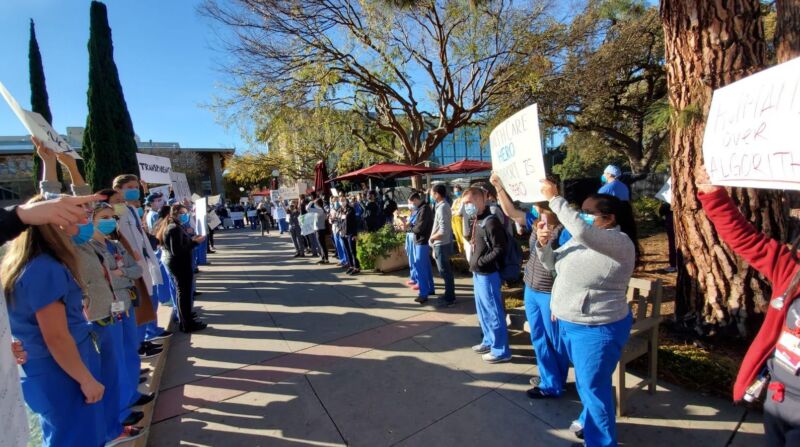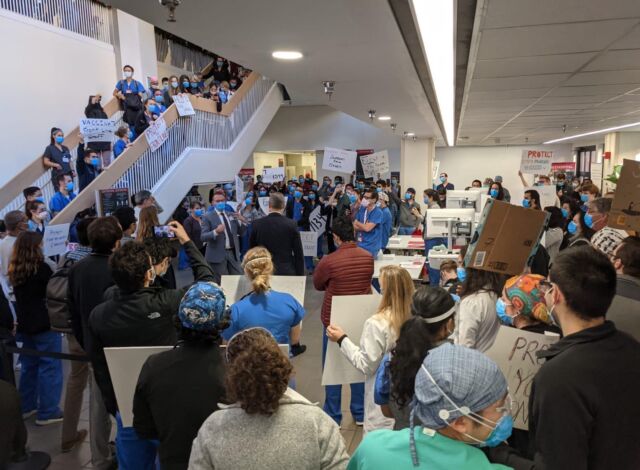Stanford hospital erupts in protest after vaccine plan leaves out residents [UPDATED]

Update, 10:00pm EST: Stanford Medicine shared the following statement with Ars: “We take complete responsibility for the errors in the execution of our vaccine distribution plan. Our intent was to develop an ethical and equitable process for distribution of the vaccine. We apologize to our entire community, including our residents, fellows, and other frontline care providers, who have performed heroically during our pandemic response. We are immediately revising our plan to better sequence the distribution of the vaccine.”
Update, 7:15pm EST: According to the Washington Post, Stanford has apologized and announced that it would re-prioritize vaccine distributions immediately in order to move more of its front-line staff into the first wave of vaccinations.
The original story follows.
One of the more challenging aspects of the initial round of vaccinations is deciding who gets the first doses of a limited supply. The need to have a functional medical system in the face of an out-of-control pandemic has meant that most places have prioritized doctors and nurses who provide most face-to-face patient care. But an apparent failure to prioritize those caregivers at Stanford Medical Center has caused many of its doctors to stage protests today.
Ars received a copy of an open letter sent by the Chief Medical Residents to the Stanford administration that outlines the problems that sparked these protests.
In the US, a residency occurs after the completion of medical school, and is a requirement for the practice of medicine. Residents typically operate under the supervision of a physician in a training program at teaching hospitals, and they learn to practice a specialized branch of medicine, such as internal medicine or pediatrics. In many cases, residencies are followed by fellowships, which are used to develop further specializations. Because these positions are both temporary and required for practicing medicine, however, those occupying them have little political weight within hospitals.
Despite their lack of input into the management of most hospitals, residents and fellows provide most of the direct care to patients that’s provided by MDs (nurses and other patient care specialists provide a great deal as well). As such, the residents would be expected to be at highest risk of exposure to the SARS-CoV-2 coronavirus. However, according to the figures cited in the letter, less than one percent of the residents and fellows at Stanford will be vaccinated using the first round of doses.
Despite what seems like an obvious lapse, an email sent to residents by Stanford’s Chief Medical Officer Niraj Sehgal and provided anonymously to Ars indicated that the plan would go forward regardless. Despite Seghal’s email explicitly stating “I personally couldn’t feel worse about it,” the Thursday message suggests that the priority for the administration is simply understanding what went wrong. Residents are expected to wait until next week, when more vaccine is expected to be available.

That response triggered an outraged letter (also sent yesterday) from 17 chief residents at the hospital. It also launched the protests that took place today. The chief residents’ letter describes the problems in detail.
Despite reiterated promises to prioritize house staff front-line providers in this initial phase of vaccine administration, we have learned only seven residents/fellows were ultimately included. There is still no articulated plan to vaccinate the remaining 1,300+ residents and fellows, including those on the front line directly treating COVID-19 patients.
…
Stanford’s decision to de-prioritize residents and fellows is defenseless on the basis of science, reason, ethics, and equality. Many of us know senior faculty who have worked from home since the pandemic began in March 2020, with no in-person patient responsibilities, who were selected for vaccination. In the meantime, we residents and fellows strap on N95 masks for the tenth month of this pandemic without a transparent and clear plan for our protection in place.
This letter requests a number of steps in response to the immediate problem, including an explanation of how the algorithm produced the results that it did, and an explanation of why, if its output was apparently known as early as Tuesday, the administration decided to follow through with the plan it produced even though it had three days to devise a better one. The residents demand a plan that gets them vaccinated as quickly as possible, while allowing the injections to be staggered because of the expected flu-like symptoms that often result as the immune system responds to the vaccine.
Longer term, it lists items that would be needed to restore the confidence of the residents in the hospital’s administration. These largely revolve around putting representatives of the residents in positions of power within the hospital’s hierarchy, including on the hospital’s Board of Directors and Graduate Medical Education Committee. In the meantime, protests have continued throughout the day on Friday.
Determining how to prioritize a limited resource is going to create lots of tension over the next six months, and there will be decisions that are arguable, even if they are well intentioned. If the chief residents’ account is accurate, however, it’s hard to consider this plan to be well intentioned. Instead, it appears that the administration outsourced decision making to an algorithm and didn’t question its output even after it was obvious that it was problematic.
We’ve asked Stanford for comment and will update this story if we receive any.
https://arstechnica.com/?p=1730882